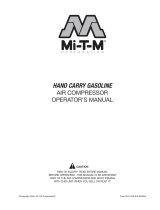
Typical Permanent Mounting (Customer Supplied Hardware)
Flat Washer I
X ..f_..._3t8" Lag Screw
Isolator \ _...fq
11\ \
Shim beneath Floor line
isolator washer, if
necessary Lag screw anchor
for concrete
GASOLINE ENGINE UNITS. Bolt the unit to a firm, level
foundation. Do not bolt uneven feet tightly to the foundation, as this
will cause excessive stress on the receiver tank. Use metal shims
under the "short" feet if necessary. Gasoline engine units mounted
on truck beds must be fastened securely without applying excessive
stress on the receiver tank. We recommend installing a vibration
isolator kit with gasoline engine models.
INSTALLING REMOTE AIR INLET PIPING
/_ CAUTION Do not operate the unit without air inlet filtration.
If the air around the unit is relatively free of dirt, install the air inlet
filter at the inlet connection at the pump. If the air is dirty, pipe the
filter to a source of clean air. Use PVC plastic tubes for remote inlet
piping. Do not use black pipe or galvanized pipe, as these promote
sweating and rust. Consider installing an in-line type filter for ease
of cleaning and replacement. Make the line as short and direct as
possible and as large, or larger, than the diameter of the inlet
connection on the pump. Do not install piping with a diameter lower
than that of the pump intake.
Increase the pipe diameter one size for every 10 feet (3 m) of length
or every 90 ° bend. Make sure the piping is adequately braced.
If you pipe the filter outdoors, cover it with a hood to prevent the
entrance of rain or snow.
Heavy duty filter elements and filtration equipment are available for
fine airborne dust, such as cement and rock dust.
Typical Remote Air Inlet Piping.
ELBOW__
Direct to compressor SUPPORT-- [_
a_rIienta_a(ifdifsta._ce I I
/ P,PE--II
122 .mLL
F"T'NG/
BUSHINGS /
DRAIN VALVE
m
HOOD
AIR INLET
FILTER
-- OUTSIDE
WALL
INSTALLING
/k WARNING
A CAUTION!
DISCHARGE PIPING
Do not use plastic pipe, soldered copper fittings,
rubber hose, or lead-tin soldered joints anywhere in
the compressed air system.
If you will be using synthetic compressor lubricant,
all downstream piping material and system
components must be compatible. Refer to the
following material compatibility list. If there are
incompatible materials present in your system, or if
there are materials not included in the list, contact
Ingersoll-Rand for recommendations.
SYNTHETIC COMPRESSOR LUBRICANT
MATERIAL COMPATIBILITY LIST
SUITABLE
Viton®, Teflon®, Epoxy (Glass Filled), Oil Resistant Alkyd, Fluorosilicone,
Fluorocarbon, Polysulfide, 2-Component Urethane, Nylon, Delrin®,
Celcon®, High Nitrile Rubber (Buna N. NBR more than 36% Acrylonitrile),
Polyurethane, Polyethylene, Epichlorohydrin, Polyacrylate, Melamine,
Polypropylene, Baked Phenolics, Epoxy, Modified Alkyds
(® indicates trademark of DuPont Corporation)
NOT RECOMMENDED
Neoprene, Natural Rubber, SBR Rubber, Acrylic Paint, Lacquer, Varnish,
Polystyrene, PVC, ABS, Polycarbonate, Cellulose Acetate, Low Nitrile
Rubber (Buna N. NBR less than 36% Acrylonitrile), EPDM, Ethylene Vinyl
Acetate, Latex, EPR, Acrylics, Phenoxy, Polysulfones, Styrene Acrylonitrile
(San), Butyl
NOTE All compressed air systems generate condensate
which accumulates in any drain point (e.g. tanks,
filters, drip legs, aftercoolers, dryers). This
condensate contains lubricating oil and/or
substances which may be regulated and must be
disposed of in accordance with local, state, and
federal laws and regulations.
GENERAL REQUIREMENTS. The piping, fittings, air receiver tank,
etc. must be certified safe for at least the maximum working
pressure of the unit. Use hard-welded or threaded steel or copper
pipes and cast iron fittings that are certified safe for the unit's
discharge pressure and temperature. DO NOT USE PVC PLASTIC
IN THE COMPRESSED AIR DISCHARGE LINE. Use pipe thread
sealant on all threads, and make up joints tightly to prevent air
leaks.
CONDENSATE DISCHARGE PIPING. If installing a condensate
discharge line, the piping must be at least one size larger than the
connection, as short and direct as possible, secured tightly and
routed to a suitable drain point or waste container. Condensate
must be disposed of in accordance with local, state, and federal
laws and regulations.
A WARNING If an aftercooler, check valve, block valve, or any
other restriction is added to the compressor
discharge, install a properly-sized ASME approved
safety/relief valve between the compressor
discharge and the restriction.
INSTALLING
UNITS)
A WARNING
ELECTRICAL WIRING (ELECTRIC MOTOR
Electrical installation and service should be
performed by a qualified electrician who is familiar
with all applicable local, state and federal laws and
regulations.
GENERAL. The motor rating, as shown on the motor nameplate,
and the power supply must have compatible voltage, phase and
hertz characteristics.
WIRE SIZE. The electrical wiring between the power supply and
electric motor varies according to motor horsepower and other
factors. Install adequately sized power leads to protect against



















